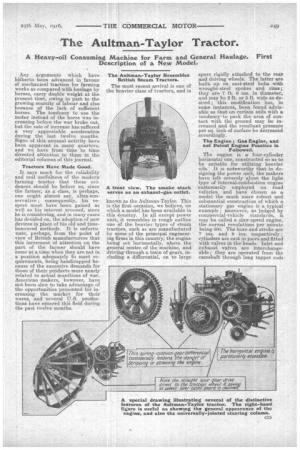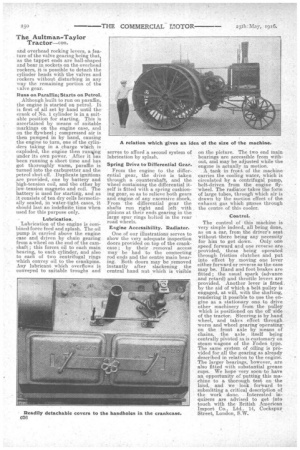The Aultman-Taylor Tractor.
Page 7

Page 8

If you've noticed an error in this article please click here to report it so we can fix it.
A Heavy-oil Consuming Machine for Farm and General Haulage. First Description of a New Model.
Any arguments which have hitherto been advanced in favour of mechanical traction for farming works as compared with haulage by horses, carry double weight at the present time, owing in part to the growing scarcity of labour and also because of the lack of sufficient horses. The tendency to -use the motor instead of the horse was increasing before the war broke out, but the rate of increase has suffered a very appreciable acceleration during the last twelve months. Signs of this unusual activity have been apparent in many quarters, and we have from time to time directed attention to them in the editorial columns of this journal.
Tractors Rave Made Good.
It says much for the reliability and real usefulness of the modern farming tractor that these evidences should be before us, since the farmer, as a class, is perhaps, one might almost say, ultra-conservative ; consequently, his respect must have been gained as well as his interest aroused, since he is considering, and in many cases has decided on, the adoption of new devices in place of his old and timehonoured methods. It is unfortunate, perhaps, from the point of view of British manufacturers that this increment of attention on the part of the farmer should have come at a time when they are not in a position adequately to meet requirements, being handicapped because of the excessive demands for those of their products more nearly related to actual munitions of war. American makers, however, have not been slow to take advantage of the opportunities presented for increasing the market for their wares, and several U.S. productions have entered thii field during the past twelve months.
The Aulttnan-Taylor Resembles British Steam Tractors.
The most recent arrival is one of the heavier class of tractors, and is known as the Aultman-Taylor. This is the first occasion, we believe, on which a model has been available in this country. In all except power unit, it resembles in rough outline one of the heavier types of steam tractors, such as are manufactured by some of the principal engineering firms in this country, the engine being set horizontally, above the general centre of the machine, .and driving through a train of gears, including a differential, on to large
spurs rigidly attached to the rear and driving wheels. The latter are built s up on cast-steel hubs with wrought-steel spokes and rims ; they are 7 ft. 6 ins, in diameter, and may be 2 ft. or 3 ft. wide a.s desired ;. this modification has, in some instances, been found advisable so that on certain soils with a tendency-to pack the area of contact with the ground may be increased and. the resultant pressure per sq. inch of surface be decreased accordingly.
The Engine ; Gas Engine, and not Petrol Engine Practice is Followed.
The engine is a four-cylinder horizontal one, constructed so as to be suitable for utilizing heavier oils. It is noteworthy that in designing the power unit, the makers have left severely alone the light type of internal-combustion engine customarily employed on road vehicles, and have chosen as a model the much more robust and substantial construction of which a stationary gas engine is a typical example ; moreover, as judged by commercial-vehicle standards, it may be Called a. slow-speed engine; the normal revolutions per minute being 500. The bore and stroke are 7 ins, and 9 ins. respectively ; cylinders are east in pairs and fitted with valves in the-heads. Inlet and exhaust valves are interchangeable ; they are operated from the camshaft through long tappet rods
and overhead rocking levers, a feature of the valve gearing being that, as the tappet ends are ball-shaped and bear in sockets on the overhead rockers, it is possible to detach the cylinder heads with the valves and rockers without disturbing in any way the remaining portion of the valve gear.
Puns on Paraffin; Starts on Petrol.
Although built to run on paraffin, the engine is started on petrol. It is first of all set by hand until the crank of No. 1 cylinder is in a suitable position for starting. This is ascertained by means of suitable markings on the engine case, and on the flywheel ; compressed air is then pumped in by hand, causing the engine to turn, one of the cylinders taking in a charge which is exploded, the engine then runiking Under its own power. After it has been running a short time and has got thoroughly warm, paraffin is turned into the carburetter and the petrol shut off. Duplicate ignitions are provided, one by battery and high-tension coil, and the other by low-tension magneto and coil. The battery is used for starting, and as it consists of ten dry cells hermetically sealed, in water-tight cases, it should last an indefinite time when used for this purpose only, • Lubrication.
Lubrication of the engine is combinectforce feed and splash. The oil pump is carried above the engine case and driven by chain gearing from a wheel on the end of the camshaft; this forces oil to each main bearing, to each cylinder, and also to each of two centrifugal rings which convey oil to the crankpins. Any lubricant which overflows is conveyed to suitable troughs and serves to afford a second system of lubrication by splash.
Spring Drive to.Differential Gear.
From the engine to the differential gear, the drive is taken through a countershaft, and the wheel containing the differential itself is fitted with a spring cushioning gear, so as to relieve both gears and engine of any 6icessive, .shock. From the differential gear the shafts run right and left with pinions at their ends gearing in the large spur rings bolted in the rear road wheels.
Engine Accessibility. Radiator.
One of our illustrations serves to show the very adequate inspection doors provided on tap of the crankcase ; by their removal access may be had to the connecting rod ends and the centre main bearing. Both doors may be removed instantly after slackening the central hand nut which is visible
on the picture. The two end Main bearings are accessible from without, and may be adjusted while-the engine is actually in motion, A tank in front of the machine carries the cooling water, which is circulated by a centrifugal pump, belt-driven from the engine fly'wheel. The radiator takes the form of large tubes, through which air is drawn -by the suction effect of the exhatist gas which passes through the centre of this cooler:
Control. • The control of this machine is very simple indeed, all being done, as on a ear, from the driver's seat without .there being any necessity for him to get down. Only one speed forward and one reverse are
• proVided, these being operated through friction clutches and put into effect by moving one lever either forward or reverse as the case may be. Hand and foot brakes are fitted ; the usual spark (advance and retard) and throttle levers are provided. Another lever is fitted by the aid of which a belt pulley is engaged, at will, with the shafting, rendering it possible to use the engine as a, stationary one to drive other machinery from the pulley which is positioned on the off'side of the tractor. Steering is by band wheel, and takes effect through. worm and wheel gearing operating' on the front axle by means of chains, the axle itself being centrally pivoted as is customary on. steam wagons of the Foden type. The same system. of oiling is pravided for all the gearing as already described in relation to the engine. The larger bearings, however, are also fitted with substantial grease cups. We hope very soon to have an opportunity of putting this machine to a thorough test on the land, and we look for'Ward to submitting a critical description of the work done. Interested inquirers are advised to get into touch with the British American Import Co., Ltd.. 14, Cockspur Street, London, S.W.




















